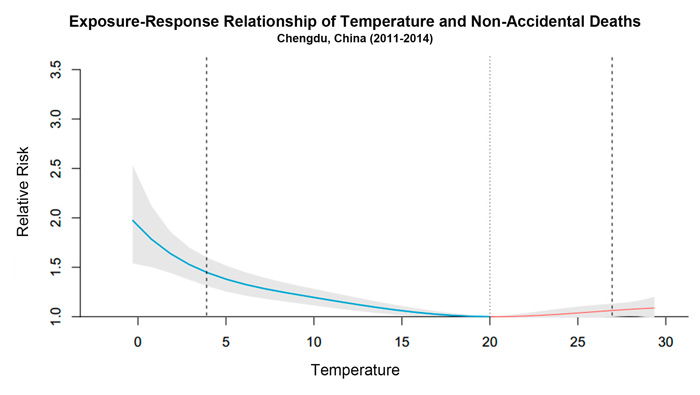| Tweet | Follow @co2science |
Paper Reviewed
Cui, Y., Yin, F., Deng, Y., Volinn, E., Chen, F., Ji, K., Zeng, J., Zhao, X. and Li, X. 2016. Heat or Cold: Which one exerts greater deleterious effects on health in a basin climate city? Impact of ambient temperature on mortality in Chengdu, China. International Journal of Environmental Research and Public Health 13: 1225; doi:10.3390/ijerph13121225.
Contemplating the so-called Social Cost of Carbon (SCC), many governments are attempting to tally the economic impacts of rising CO2 emissions, which efforts have largely turned into an exercise to demonize CO2 and a means to justify their ill-conceived desire to regulate and tax this life-giving molecule. However, calculations of the SCC are far from realistic, ignoring the many direct benefits of CO2 on plant growth (e.g., agriculture and crop yields). More importantly, they neglect to incorporate multiple indirect benefits of fossil fuel use that have improved life and the human economy over the past two centuries, which if considered would far exceed the supposed social costs of carbon ... and by orders of magnitude!
One such indirect benefit of CO2 that is largely ignored in SCC calculations is found in scientific studies examining the relationship between temperature and human mortality and the latest such analysis to explore this benefit comes from the work of Cui et al. (2016). Publishing in the International Journal of Environmental Research and Public Health, this nine-member research team set out to examine which end of the temperature spectrum (hot or cold weather) exerts a greater deleterious effect on human health.
To accomplish their objective, they focused their analysis on the largest city within the Sichuan Province of China, Chengdu, which boasts a population of 14.65 million. Therein, they gathered daily meteorological and death record data for the period 1 January 2011 through 31 December 2014 and estimated the relationship between daily mortality and ambient temperature using a distribution lag model with a quasi-Poisson regression, while controlling for long time trends and day of the week. Furthermore, they calculated the relative risk of mortality, defined as the risk of death attributable to heat or cold above or below the optimum temperature at which minimum mortality occurred.
So what did their research reveal?
In the words of Cui et al., the "total fraction of deaths caused by both heat and cold was 10.93%." However, they note that "the effect of cold was significant and was responsible for most of the burden," whereas "the effect of heat was small and non-significant." Indeed the effect of cold temperatures was calculated to be ten times larger than that of warm temperatures (9.96% vs 0.97%)! And with respect to the relative risk of death, the figure below further illustrates the far greater impact of cold temperatures.

Figure 1. The exposure-response relationship of temperature and non-accidental deaths in Chengdu, China over the period 2011-2014. The blue part of the curve is the exposure-response association (with 95% empirical confidence interval, shaded grey) of cold, and the red one presents the heat. The dotted line is minimum mortality temperature and the dashed lines are the 2.5th and 97.5th percentile. Adapted from Cui et al. (2016).
Commenting on their work, Cui et al. note that "a growing trend in public health research is to focus on heat waves, and correspondingly, recent policies and interventions that have been aimed to reduce the impact of heat waves." However, they rightfully suggest that, "in accordance with our results, they should be extended and readjusted to the whole range of temperature dependent effects, especially cold days." We couldn't agree more. Why spend the vast bulk of research dollars and focus policy near-exclusively on reducing the impacts of global warming on human health when rising temperatures will have negligible impact on death rates at the warm end of the temperature spectrum and save lives at the cold end?
It is time governments recognize the indirect health benefits of CO2 and properly include such benefits of saving lives in their SCC estimates.
Posted 10 January 2017



